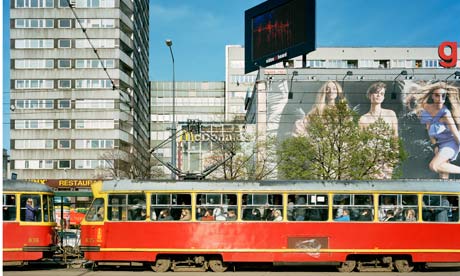
In his essay for this book, the Polish novelist Marek Bienczyk notes that Mark Power's photographs ask a "vital and unsolved – or rather, unsolvable – question" about Poland: is this often fragmented, crippled space only an image of contemporary reality, or is it also a place of memory?
Power's photographs of contemporary Poland, taken over five years, often present what the writer Iain Sinclair has called "liminal" landscapes: in-between places often on the outskirts of cities, neglected and overlooked, neither here nor there. Power's Poland looks like a country entirely composed of liminal spaces: desolate housing estates, half-finished building sites, municipal buildings that carry the imprint of Soviet architecture and bureaucracy.
There is beauty here too, though, as there is in all Power's photographs: the beauty of stillness, silence and muted colours. One could say that Power, a Magnum photographer whose best-known work is The Shipping Forecast – a collection of photographs of the sea areas featured in the BBC's daily weather bulletins of that name – is a melancholic romantic despite the surface realism of his photography. The term "real and imagined spaces" is often applied to Power's work and, as Bienczyk notes, "we find ourselves in what the French call terrain vague, a territory that is undefined, formless, mediocre".
Power punctuates his impressionistic visual narrative with portraits of Poles young and old, who stare at the camera without giving anything away. He photographs expansive car parks, shopping malls and blocks of flats: the new Poland, existing in a suspended state, definably east European but slowly being colonised by the consumerist temples of the west. There are hints of an older past: broken-down churches; dense, uncultivated forests. In one unforgettable image, truncated ventilation pipes lie piled up in the corner of a desolate concrete warehouse. The power of that image, like many in this fascinating book, resides in its suggestiveness, in what it hints at rather than records. A book you spend time with, then, and one whose stories unfold slowly and almost subliminably.

